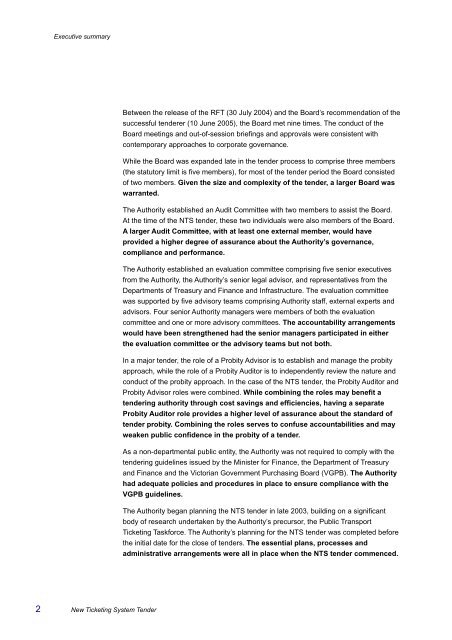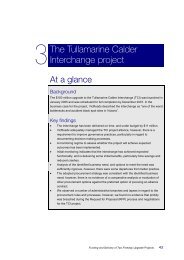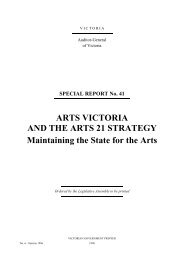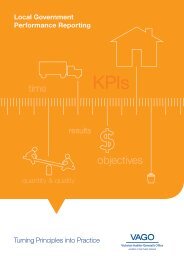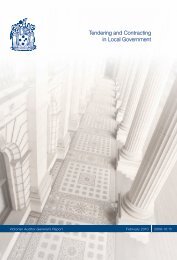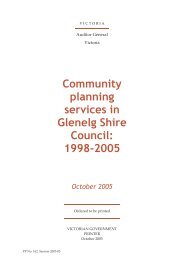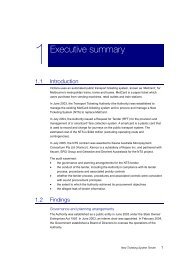New ticketing system tender
New ticketing system tender
New ticketing system tender
Create successful ePaper yourself
Turn your PDF publications into a flip-book with our unique Google optimized e-Paper software.
Executive summary<br />
2 <strong>New</strong> Ticketing System Tender<br />
Between the release of the RFT (30 July 2004) and the Board’s recommendation of the<br />
successful <strong>tender</strong>er (10 June 2005), the Board met nine times. The conduct of the<br />
Board meetings and out-of-session briefings and approvals were consistent with<br />
contemporary approaches to corporate governance.<br />
While the Board was expanded late in the <strong>tender</strong> process to comprise three members<br />
(the statutory limit is five members), for most of the <strong>tender</strong> period the Board consisted<br />
of two members. Given the size and complexity of the <strong>tender</strong>, a larger Board was<br />
warranted.<br />
The Authority established an Audit Committee with two members to assist the Board.<br />
At the time of the NTS <strong>tender</strong>, these two individuals were also members of the Board.<br />
A larger Audit Committee, with at least one external member, would have<br />
provided a higher degree of assurance about the Authority’s governance,<br />
compliance and performance.<br />
The Authority established an evaluation committee comprising five senior executives<br />
from the Authority, the Authority’s senior legal advisor, and representatives from the<br />
Departments of Treasury and Finance and Infrastructure. The evaluation committee<br />
was supported by five advisory teams comprising Authority staff, external experts and<br />
advisors. Four senior Authority managers were members of both the evaluation<br />
committee and one or more advisory committees. The accountability arrangements<br />
would have been strengthened had the senior managers participated in either<br />
the evaluation committee or the advisory teams but not both.<br />
In a major <strong>tender</strong>, the role of a Probity Advisor is to establish and manage the probity<br />
approach, while the role of a Probity Auditor is to independently review the nature and<br />
conduct of the probity approach. In the case of the NTS <strong>tender</strong>, the Probity Auditor and<br />
Probity Advisor roles were combined. While combining the roles may benefit a<br />
<strong>tender</strong>ing authority through cost savings and efficiencies, having a separate<br />
Probity Auditor role provides a higher level of assurance about the standard of<br />
<strong>tender</strong> probity. Combining the roles serves to confuse accountabilities and may<br />
weaken public confidence in the probity of a <strong>tender</strong>.<br />
As a non-departmental public entity, the Authority was not required to comply with the<br />
<strong>tender</strong>ing guidelines issued by the Minister for Finance, the Department of Treasury<br />
and Finance and the Victorian Government Purchasing Board (VGPB). The Authority<br />
had adequate policies and procedures in place to ensure compliance with the<br />
VGPB guidelines.<br />
The Authority began planning the NTS <strong>tender</strong> in late 2003, building on a significant<br />
body of research undertaken by the Authority’s precursor, the Public Transport<br />
Ticketing Taskforce. The Authority’s planning for the NTS <strong>tender</strong> was completed before<br />
the initial date for the close of <strong>tender</strong>s. The essential plans, processes and<br />
administrative arrangements were all in place when the NTS <strong>tender</strong> commenced.


